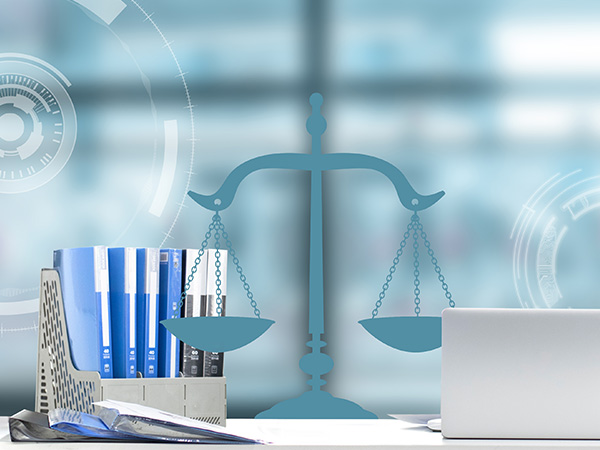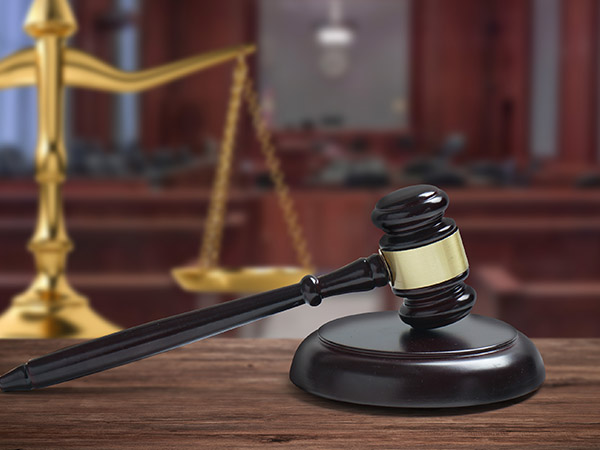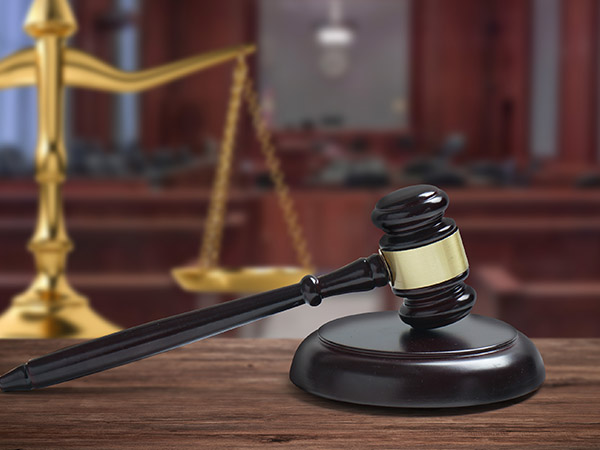Preserving evidence with blockchain
Preserving is the first step in the application of blockchain technology in the judicial field.
Take the case of the Hangzhou Internet Court mentioned at the beginning of this article, the court identified the technical evidence of the blockchain in the case as “data telex”. According to the Article 8 of the Electronic Signature Law of the People's Republic of China, the following elements shall be considered in the scrutiny of the authenticity of data telex as evidence:
Reliability of the means of creation, storage and transfer methods of data telex;
Reliability of the means of maintaining the completeness of the content;
Reliability of the methods of identifying the senders;
(4) Other related elements.
Based on this, the Hangzhou Internet Court determined the validity of the electronic evidence involved from the following perspectives:
Qualification review of the platform who preserved the evidence
There are no clear provisions regarding qualification for an entity to preserve the electronic evidence. The preservation of evidence is not an electronic certification service stated in the Electronic Signature Law of the People's Republic of China. However, if the platform needs to preserve the evidence by electronic signature, or preserve t h e e v i dence r e g a r d i n g t h e individual’s identity, it should be a qualified electronic certification service provider.
The court also conducted a formal examination, reviewing whether there existed any conflict of interests between the platform and the person who wants to preserve the evidence.
Credibility review of the technical means of collecting evidence of an infringing webpage
Data storage security environment
To prove that BaoQuan has a security environment for electronic data storage, the court conducted a formal review of the BaoQuan docking Alibaba Cloud BGP data center, Alibaba Cloud security, and BaoQuan information security.
Data capture is conducted under internet environment
When a BaoQuan server receives an infringing webpage URL, it will automatically request the target address in the internet environment, and the target address automatically returns the status code and the webpage information to confirm that the requested URL is a valid and accessible address. This ensures the data capture of the infringement link is performed under the internet environment;
(iii) Credibility of the data capture technology BaoQuan automatically uses Puppeteer, a Google open source program, to capture the image of the target webpage, and obtains the target webpage source by using curl at the same time.
Such a program can be used by everyone, and the operation process is automatically completed by the default program, so it’s less likely to be modified and the source of electronic data is highly reliable.
(iv) Judicial evaluation Zhejiang Chain Forensic Science Center evaluated and confirmed the technicality of the above process, i.e., using the Puppeteer and curl programs to take web pages screenshots and source code retrieval.
Completeness review of evidence preserved with blockchain
The court analysed the technology characters of blockchain first, once the electronic evidence involved is recorded in the given block, the data cannot be altered retroactively without alteration of all subsequent blocks, while the consensus of the all network is very hard, so it’s reliable to keep the completeness of the evidence after the data is preserved in the chain.
Simultaneously, to ensure the data has been recorded in the chain, the court conducted reviews from two aspects:
(i) Whether the data has been uploaded The court compared the hash value in the specified block of bitcoin chain and that of FACTOM, they are the same, so the court ruled BaoQuan has uploaded the electronic data to FACTOM and bitcoin chain.
Whether the data is the specified data involved
The court calculated the hash of webpage-capture downloaded from BaoQuan, source code, and the call information compressed documents, then compared the hash with the value preserved in the block by the party. They were the same.
From the above process, we can see that the Hangzhou Internet Court considered various factors involved, not just that the evidence was preserved with blockchain.
On the same day of the judgement, the Hangzhou Internet Court announced the launch of the first electronic evidence platform and issued the Hangzhou Internet Court Electronic Evidence Platform Provisions (Provisions) and Hangzhou Internet Court Civil Litigation Electronic Evidence Judicial Review Rules (Rules).
According to the Provisions, both official electronic data ( including electronic data created by government organs, public institutions, etc.), and private electronic data (including electronic data created by notary organizations, the holder of the third-party data, the service provider of the third party, and other entities or individuals who hold electronic data) can be accessed by the Hangzhou Internet Court electronic evidence platform. Moreover, the official electronic data, the notarized electronic data, and the electronic data of the third-party data holders can not only be accessed the evidence platform, but also the litigation platform. Other private electronic data should be accessed by the evidence platform first.
In September 2018 , the Supreme People's Court issued the Provisions of the Supreme People’s Court on Several Issues Concerning the Hearing of Cases by Internet Court, acknowledging the validity of blockchain deposits in internet cases. Subsequently, the Beijing and Guangzhou Internet Courts were established. This means that in the context of unambiguous laws and increasing number of Internet courts, blockchain will be used in evidence preservation on a larger scale.
Some ordinary courts have adopted an open attitude towards blockchain evidence. For example, in February 2018, the Lishui Intermediate Court in Zhejiang Province admitted the evidence preserved with block chain in a trade mark infringement case of Hangzhou Woodpecker Footwear Co., Ltd. v. Qingtian Woodpecker Footwear Co., Ltd., and BEIJING JINGDONG 360 DU E-COMMERCE LTD.
Coincidentally, on September 5, 2018, Dongcheng District People’s Court in Beijing also accepted evidence preserved with blockchain in the copyright case of Chinese All Digital Publishing Group Co,Ltd. v. BEIJING JINGDONG 360 DU E-COMMERCE LTD.
How to establish a Complete Electronic Evidence Chain-Judicial Blockchain?
However, despite the electronic evidence platform of the Hangzhou Internet Court, or the court accepting the evidence preserved with blockchain, it only solves the problem of electronic data preservation. It has nothing to do with obtaining the electronic evidence. Is there any method to establish a complete chain to ensure the reliability and authenticity of electronic evidence from its generation, transmission, storage, and final submission? The answer is yes.
On September 18, 2018, the Hangzhou Internet Court launched the first judicial blockchain in China. Here is the graphic illustration of the Hangzhou Internet Court Judicial Blockchain.
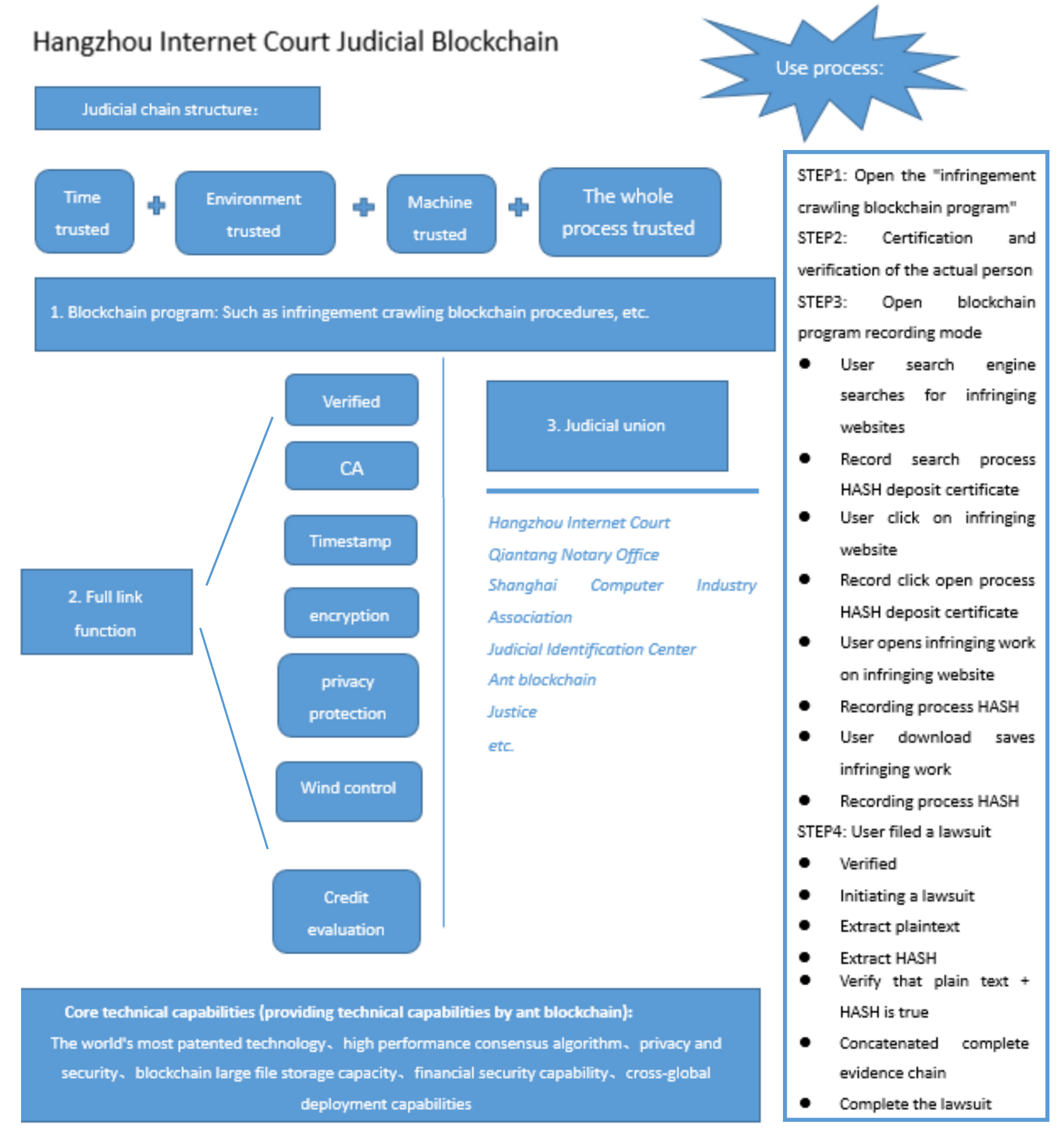
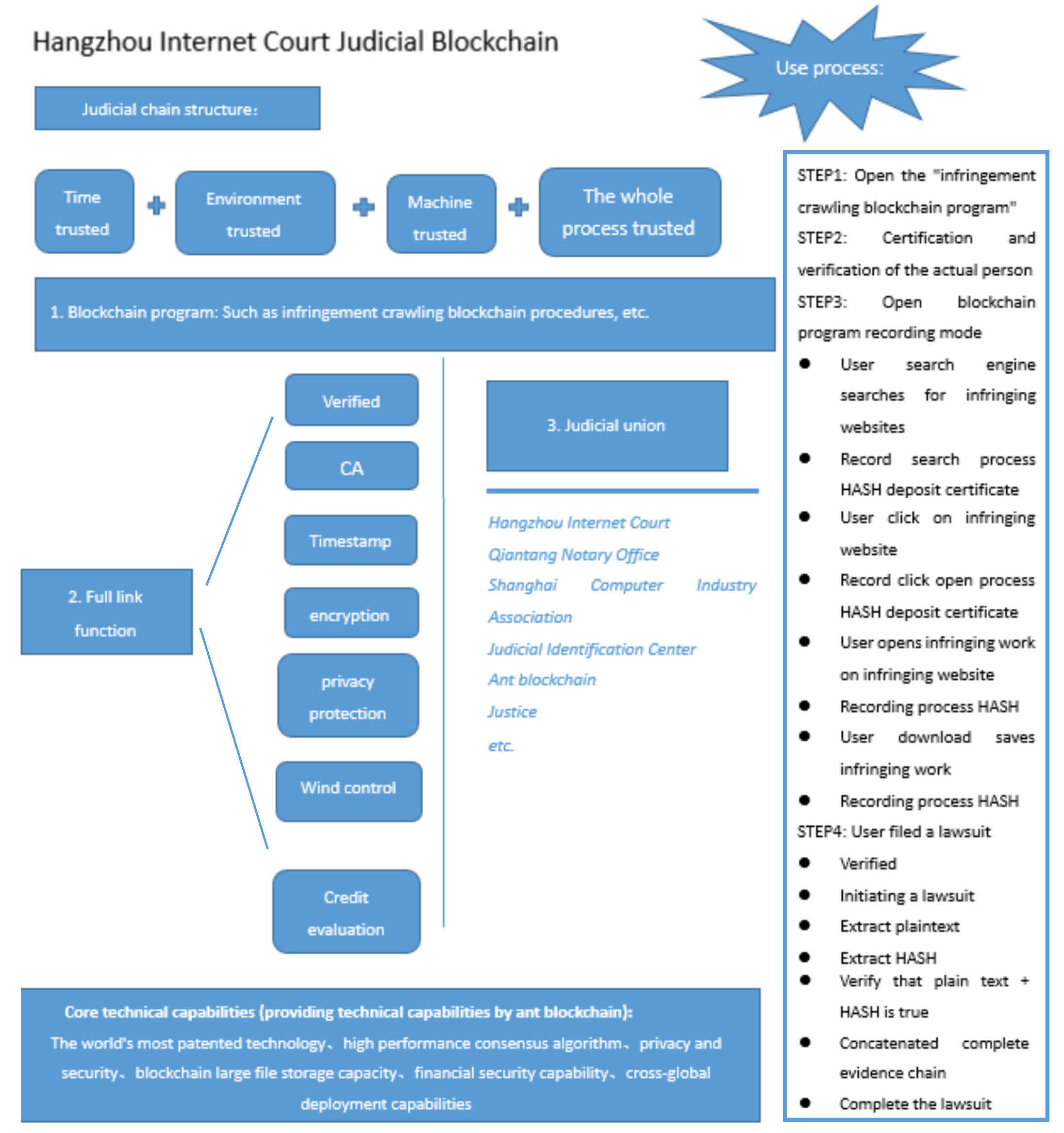
The entire blockchain has a three-layered framework. The first part is to capture and preserve evidence with blockchain technology.
The second part related to the function of the whole chain, guarantees the security and reliability of the entire judicial blockchain through real-name identity authentication, digital signature authentication (CA authentication), time stamp proof, and encryption algorithm, etc.
The third part is the chain of judicial alliances. At this stage, the Hangzhou Internet Court is the core of the judicial alliance chain, which also includes the notary offices, the judicial appraisal agencies and the evidence preservation service providers. As the distributed blocks of the judicial alliance chain, all these offices/ agencies/providers form a complete judicial chain.
For example, if a writer finds there has been an infringement article on a certain web, how can they preserve the evidence through the judicial blockchain? Firstly, they should authenticate their real name and open the record system of the judicial blockchain. In the ordinary way, they may access certain search engines such as Google or Baidu. When they visit the web, there will be created a hash value, which will be preserved in a local server of each block.
Secondly, they may find the infringement through the search engine, that will also create and preserve a hash value.
Thirdly, open the infringement article on the web, it will create and preserve a hash value.
Fourthly, download the infringement article to the applicant’s local server, it will create and preserve a hash value as well.
In other words, the judicial block chain generates a corresponding hash value for each process of obtaining electronic data when using, and these hash values are synchronously generated and published to the local servers of all blocks.
If a lawsuit is involved , the user can register in the Hangzhou Internet Court Litigation Platform and bring the suit, submitting the electronic source documents as electronic data evidence. The system will compare the hash value which user previously stored at local server in the Hangzhou Internet Court with the source value of the evidence submitted by the user to see whether there has any tampering. If the system verifies, it means the evidence is true and can be used as the evidence for the plaintiffs or defendants.
Currently common users cannot save and submit evidence through the judicial blockchain by themselves, but they can process through the judicial alliance members in the judicial chain.
Doubts and the Future
There are also dissenting voices about blockchain’ s application in the IP sector.
Concerns exist squatting issues will increase because enterprises may register more IP rights with much less cost. If all IP registration can be done through blockchain, people may register more IP rights than previously. This could create more patent trolls or patent thickets.
People may obtain published information through blockchain more easily, make small revisions and register a new right in the blockchain. This may result in the right owner reducing publication in the blockchain to avoid being imitated, which conflicts with open innovation.
Some doubts relate to the technology itself. For instance, the current recognition of the original document solely relies on the results of hash value comparison. However, as a cryptographic algorithm, there always exists decryption methods. Some cryptographic algorithms, once was regarded as computationally infeasible, can be decrypted later.
For example, SHA-1, a widely used cryptographic hash algorithm, was failed by a technology attack. This was proved by Google’s collision in February 2018. We found a case where the evidence with SHA- 1 was accepted by the Zhejiang Lishui Intermediate court in May 2018. Although it’s still a low probability for the original documents to be revised even after the Google collision, it’s certain to conflict with the low tolerable error rate in judicial practice. This may need more study and research in the future.
In spite of these doubts, judicial blockchains do solve many problems of electronic evidence recognition in current judicial practice. For example, proving the internet environment for evidence preservation, the credibility of the electronic data, the storage security of the electronic data, etc. It’s expected that the preservation of electronic evidence will lead the trend in the practice, and it’s the only one method that can be developed at scale.
We believe with the development and improvement of technology, the judicial block chain will play an increasingly important role in obtaining and preserving electronic evidence in the age of the internet, and this will greatly decrease the cos t of safeguarding the rights of IP owners.







